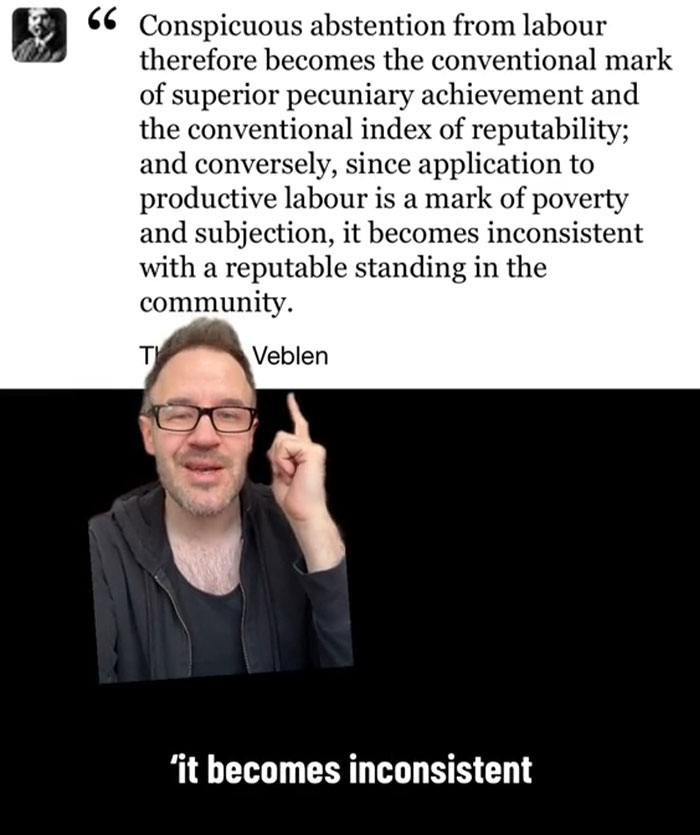Feminism has evolved over the years, and women have transformed this movement into something that empowers them to do anything they feel is right for them and their families, even if it means focusing on motherhood and leaving their careers behind.
However, the new trend of “tradwife” appears to be taking advantage of that with its pretend representations of domestic bliss. These traditional wives can be seen making bread while barefoot in a floral dress or doing their hair and putting on makeup to spend the whole day cleaning.
Noticing the harmful effects of unrealistic depictions of stay-at-home women, professor of English Neil Shyminsky took this matter to TikTok. In the video, he explains why they put on such a performance without depicting what real domestic labor actually looks like.
Scroll down to find the full video and a conversation with its creator, Neil Shyminsky, who kindly agreed to tell us more about the trend of “tradwives.”
Recently, “tradwives” like Nara Smith started going viral on TikTok

“I asked my toddlers what they wanted for breakfast and they both said cereal, so cereal it was, and we got started right away.”
This English professor made a TikTok in response to it, calling her actions performative

“Have you ever asked yourself why it is that tradwives and other conservative female influencers who promote traditional gender roles have all the time in the world to make cereal from scratch, but somehow never seem to record themselves doing essential domestic labor like vacuuming, trying to get a particularly nasty stain out of a shirt or scrubbing a toilet when they are performing labor in these videos? ”

“It’s always something that, strictly speaking, is unnecessary and they are doing it the hardest way possible, because the answer is that it is for show. It is all a performance. ”

“In his remarkably prescient 1899 book The Theory of the Leisure Class, Thorstein Veblen coined the terms conspicuous consumption and conspicuous leisure, suggesting that those with wealth and power, no longer having any economic production to contribute themselves, instead contribute to the production and consumption of leisure.
And those consumption practices, those leisure activities, are conspicuous precisely because that is how the leisure class signals their difference from the working class, signals their exceptionality and their superiority.
They’re not better than us because they can make their children’s cereal from scratch. They’re better than us because they are so wealthy and well-off that they have nothing more important to worry about. And if we were to ever see tradwives perform essential productive domestic labor or see their husbands perform any domestic labor at all, that would in fact mark them as failures as tradwives.”

“As Veblen wrote in 1899 – again, he could have written it yesterday – application to productive labor is a mark of poverty and subjection, it becomes inconsistent with a reputable standing in the community. Because these videos are not instructional. They’re maybe inspirational, but they are always performative. ”

“This is not real labor. This is symbolic labor, it is nothing more than social signaling that this woman and her family belong to the leisure class and it is also how she builds and signals her value if you are the sort of person who operates within an exchange economy that assigns high and low value to human beings.
Because her value to her husband is not in her ability to care for the home or care for the children, right? Anyone who is able to engage in this level of conspicuous leisure has somebody that they are paying to do all of those things. No, her value is instead in her ability to perform the role of trophy wife and to be the ultimate realization and personification of her husband’s socioeconomic prowess. Because tradwives are conspicuous consumers, yes, but it is the audience’s consumption of tradwives that truly makes them valuable to their husbands.”
@professorneil Tradwives are a part of the leisure class, no matter how much they pretend otherwise #tradwife #leisureclass #conspicuousconsumption #capitalism #patriarchy ♬ original sound – Professor Neil
The “tradwife” trend brings women back to the 1950s housewife—a stereotype that many of them worked so hard to break out of
For those who might be unfamiliar with this trend, the phrase “tradwife” is a combination of the words “traditional” and “wife” and refers to a female who favors a more “traditional” gender role that includes staying at home, looking after it, having children, and being dependent on the husband.
This ideology revolves around the 1950s housewife, embodying every stereotype of a woman that many of them worked so hard to break out of. This movement is largely composed of Christian, conservative millennial, and Gen Z women who are leaving the workforce and leaning into homemaking.
Some of them say that the demanding culture of corporate America has made them long for “simpler times.” Many believe in clearly defined gender roles, and a part of them wear 1950s-inspired clothing and style their hair with “Marilyn bobs.” As one of the wives, Estee Williams, tells Today, “It’s 2023, and this is my choice.”
What she says is true, as there’s nothing wrong with staying at home and raising children. However, the life of the 1950s housewife wasn’t as glamorous as they are now depicting it to be. Especially those who are making cereal from scratch and never show themselves vacuuming or scrubbing toilets.
Bored Panda reached out to professor Neil Shyminsky, whose video critiquing this trend went viral and currently has over 3.7 million views. Naturally, we were curious to know what inspired him to post such a response to the traditional wife aesthetic.
He told us, “I make a lot of videos about gender, feminism, and patriarchy, so talking about the topic of tradwives is just a natural extension of my interests. One of the things that I find particularly problematic about the tradwife movement, in addition to its sexism, is that its practitioners are so very economically privileged—often, they’re actually very wealthy. And so they promote a lifestyle that’s virtually unattainable and entirely unrealistic, even for people who may be genuinely interested in pursuing it.”
This trend poses significant threats to feminism and gender equality
For some, it’s a way to be financially stable and embrace “traditional” family values, but for others, it spreads anti-feminism and far-right propaganda, which can have dangerous effects on the younger generation.
According to Shyminsky, “The trend is explicitly anti-feminist – it’s what we might call “backlash politics,” which has a stated goal of undoing social progress and returning to an earlier, less equitable society.”
The trend is promoting one “proper choice” of life for women: putting authority in men’s hands and making themselves and their world smaller so that men can feel more important.
He further explains, “Of course, this also makes women more vulnerable and less prepared in the event that, at some point, they are on their own and lack the resources, supports, and skills to care for themselves and their family. (This is, of course, not a flaw of the tradwife movement and these traditionalist movements in general but rather it is the point – they don’t want women to be capable of caring for themselves because a capable woman might threaten the authority of her husband or even leave if she was dissatisfied.)”
Shyminsky believes that such videos as Nara Smith’s can definitely be harmful, as they discourage women from achieving independence or building the skills that might allow them to care for themselves professionally, financially, and otherwise.
He also mentioned another reason for it: “But they’re also harmful because of what they simultaneously teach men about what makes a woman desirable – deference, quiet, devotion, modesty, and so on. These men are then encouraged and emboldened to pressure their partners and prospective partners to fit the mold that’s being defined by these influencers.”
This “tradwife” movement might have originated as a reaction to the times we’re living in, related to trans rights and other different developments that the conservative circle feels threatened by. A feminist writer, Virginia Mendez, believes that this idea spreading on social media just adds fuel to those who already feel uncomfortable with the progress of women and hundreds of years of feminist fights. “Tradwives are not an issue as an individual choice, but as a trend, it is pernicious and openly anti-feminist,” she concludes.
People expressed various reactions on the matter






















